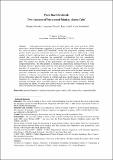Pyow-hack revisited : two analyses of putty-nosed monkey alarm calls
Abstract
Male putty-nosed monkeys have two main alarm calls, pyows and hacks. While pyows have a broad distribution suggestive of a general call, hacks are often indicative of eagles. In a series of articles, Arnold and Zuberbühler showed that putty-nosed monkeys sometimes produce distinct pyow-hack sequences made of a small number of pyows followed by a small number of hacks; and that these are predictive of group movement. Arnold and Zuberbühler claimed that pyow-hack sequences are syntactically combinatorial but not semantically compositional because their meaning cannot be derived from the meanings of their component parts. We compare two theories of this phenomenon. One formalizes and modifies the non-compositional theory. The other presents a semantically compositional alternative based on weak meanings for pyow (‘general alarm’) and hack (‘non-ground movement’), combined with pragmatic principles of competition; a crucial one is an ‘Urgency Principle’ whereby calls that provide information about the nature/location of a threat must come before calls that do not. Semantically, pyow-hack sequences are compatible with any kind of situation involving (moving) aerial predators or (arboreal) movement of the monkeys themselves. But in the former case, hacks provide information about the location of a threat, and hence should appear at the beginning of sequences. As a result, pyow-hack sequences can only be used for non-threat-related situations involving movement, hence a possible inference that they involve group movement. Without adjudicating the debate, we argue that a formal analysis can help clarify competing theories and derive new predictions that might decide between them.
Citation
Schlenker , P , Chemla , E , Arnold , K & Zuberbuehler , K 2016 , ' Pyow-hack revisited : two analyses of putty-nosed monkey alarm calls ' , Lingua , vol. 171 , pp. 1-23 . https://doi.org/10.1016/j.lingua.2015.10.002
Publication
Lingua
Status
Peer reviewed
Type
Journal article
Description
Schlenker: The research leading to these results received funding from the European Research Council under the European Union's Seventh Framework Programme (FP/2007–2013)/ERC Grant Agreement N° 324115-FRONTSEM (PI: Schlenker). Schlenker and Chemla: Research was conducted at Institut d’Etudes Cognitives, Ecole Normale Supérieure – PSL Research University. Institut d’Etudes Cognitives is supported by grants ANR-10-IDEX-0001-02 PSL* and ANR-10-LABX-0087 IEC. Arnold: The research leading to these results received funding from the Leverhulme Trust. Zuberbühler: The research leading to these results received funding from the European Research Council under ERC grant ‘Prilang 283871’ and also from the Swiss National Science Foundation under grant ‘FN 310030_143359/1’.Collections
Items in the St Andrews Research Repository are protected by copyright, with all rights reserved, unless otherwise indicated.

